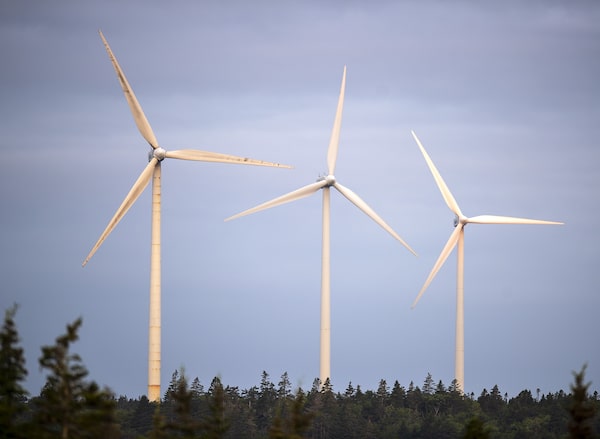
The West Pubnico Point Wind Farm in Lower West Pubnico, N.S. on Aug. 9, 2021.Andrew Vaughan/The Canadian Press
Jorden Dye is the director of Business Renewables Centre-Canada. Before joining BRC-Canada, he worked at Mount Royal University’s Institute for Environmental Sustainability.
Renewable energy is undergoing a kind of rejuvenation in Ontario, with the provincial government making two significant moves in a six-week period to restart this key spark plug in its economic engine.
These are moves geared to thriving – not just surviving – in the clean-energy future. We’re in an era now where doing right by the environment and seizing a business opportunity look like the same thing. And the Ford government’s proposal last month to allow corporations to purchase renewable energy, followed by the Independent Electricity System Operator’s announcement this month to acquire 5,000 megawatts of clean energy, will allow them to embrace both sides of this coin.
And why not, when that coin will reward landowners, municipalities and a myriad of workers about to find jobs building and operating these clean-energy projects, not to mention the investment and jobs created by bringing in new companies attracted by the renewable energy?
Climate-change consequences dominate the daily headlines and a growing chorus of companies make their interest in clean energy plain, so the Ontario government’s revived interest in renewable energy is entirely logical.
The proposal to allow companies to purchase clean energy is an opening move in the world of corporate renewable energy procurement, but business response will give them an easy win. There is definitely appetite for this. The comment period on the proposal, which would require a legislative amendment, closed Dec. 17 and is sure to reveal strong support from energy developers and buyers alike.
The proving ground is Alberta, where corporate purchases of renewable energy have supported investment of $5.5-billion since 2019. Alberta’s open market once made it easy for buyers and developers of solar and wind to work out their own clean-energy deals. In addition to the billions in investment, about 5,900 jobs were created along the way.
Added to that, municipal tax revenues have tripled to $28-million in the past few years, according to our recent analysis. For some municipalities, the renewable energy tax revenues make up 10 per cent, 30 per cent and even up to 50 per cent of their total operating revenues. Our forecast shows they could collect an additional $170-million to $250-million in the next few years.
Alberta’s provincial government recently brought turbulence to the smooth sailing there by imposing a seven-month moratorium on any new project approvals, and the uncertainty of unknown new rules on the horizon. It would not be mere speculation to say that renewable energy buyers may be eyeing other jurisdictions, such as Ontario, to spend their money. Ontario’s timing couldn’t be better, from that perspective.
Other provinces are starting to offer competition for those renewable energy dollars, though. Nova Scotia this year launched its Green Choice program, which will allow customers to purchase 100 per cent of their electricity from renewable sources. Manitoba released its Energy Roadmap, which includes a goal to support additional clean generation. And B.C. announced it will launch a call for new sources of renewable, emission-free electricity next year “to power British Columbia’s growing clean economy and create new jobs throughout the province.”
As markets in other provinces find their flexibility, it’s getting competitive out there and these recent moves show that Ontario wants to make sure it’s not left behind.
What’s driving this hot market? Companies know that renewable energy contracts can offer them a safe, cheap supply of energy. They are also driven by conscience, customers and shareholders to adopt environmental targets for emissions reductions.
Stellantis, for example, states its wants to reach net-zero status by 2038. This means the automaker will want electricity from a non-carbon-emitting source, one that it can make clear claims about when it comes to hitting its targets. While corporations associated with electric-vehicle production may have the spotlight these days in Ontario, companies in all sectors are pursuing the same goal, from candy makers such as Mars to construction giants such as EllisDon.
And though Ontario’s electricity supply is already 92 per cent carbon-free, the Independent Electricity System Operator says that in less than 30 years Ontario could need to more than double electricity generating capacity. If Ontario wants a prosperous future, plenty of new power generation will need to come online. And the provincial government now looks intent on making that happen.